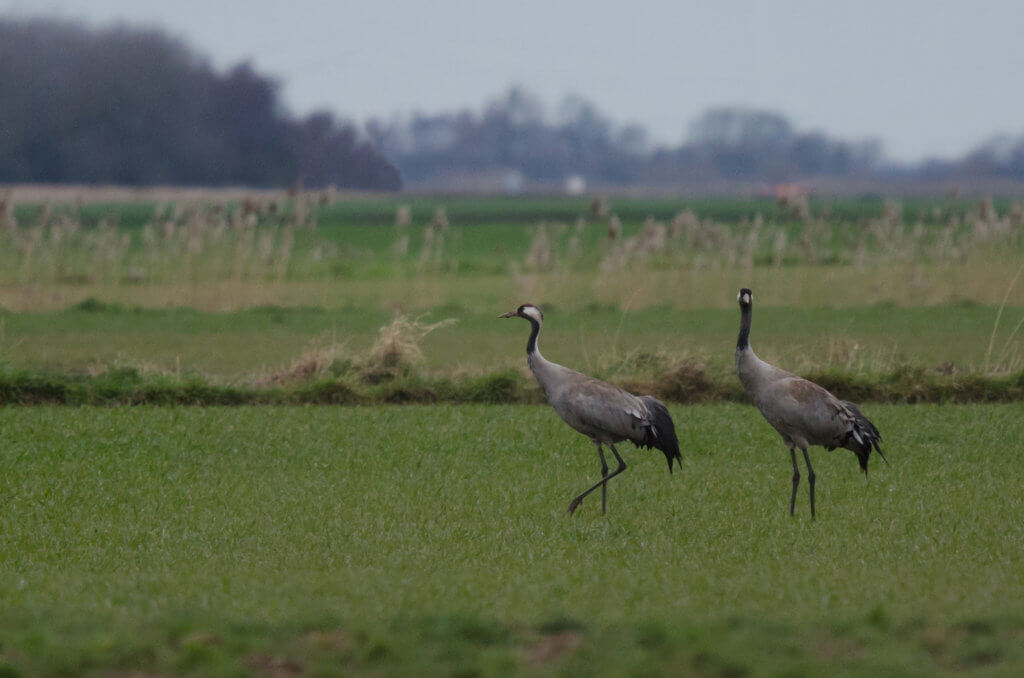
Yesterday I was at the RSPB nature reserve at Frampton Marsh on a cloudy, slightly drizzly and breezy day. But it was great, and we saw lots of birds. In fact, we saw 68 species and through the wonders of Birdtrack I know that on the same date last year, on another visit to Frampton Marsh, we saw 66 species.
Yesterday we saw a ‘Common’ Crane almost as soon as we arrived at the car park – it was wandering around in a distant grass field between the cattle. That was a good start to the day, and a decade ago or so it would have been the absolute highlight of any day’s birding. But one of many reasons for visiting Frampton from our base in east Northants is to try to see and hear a Turtle Dove and so we walked south down the wooded path listening to singing warblers and hoping to hear the purrrrring song of the Turtle Dove. And we did. And that’s what made the day.
For most of my life, Cranes have been unusual and infrequent sightings, mostly seen abroad, but now I see them in most years. In fact, thanks to Birdtrack again, I know I have seen them in 2007, 2008, 2009, 2011, 2013, 2014, 2015, 2016, 2017 (I don’t know how I missed them in 2010 and 2012).
In contrast, I used to see Turtle Doves regularly on my local patch at Stanwick Lakes – I have records in 2005, 2006, 2007 and 2008 but none there since. And my records since 2008 are mostly from nature reserves (RSPB Lakenheath, RSPB Otmoor, RSPB Berney Marshes and RSPB Frampton Marshes) and a couple of local spots where this once abundant bird is, or was, still hanging on. I missed Turtle Doves in the UK completely in 2011, 2013 and 2015.
If you have read A Message from Martha then you might remember that the story of the Passenger Pigeon ends with an account of the declines of farmland birds in Europe, including the Turtle Dove. And I wrote about the Turtle Doves at the local farm of Duncan Farrington. I heard from Duncan over the weekend saying that he had seen a Turtle Dove on his farm, a few miles from my home, on Saturday. So they are hanging on, just, with their claw tips, locally. That’s good news.

[registration_form]
I wonder if anyone anywhere has managed to see 68 species of bird during the same period on a grouse moor? They would have us believe nature reserves are empty of wildlife whilst you are tripping over it where they rabidly kill predators and burn heather to produce feathered clay pigeons.
Amazing to think that the managers of Langholm moor actually looked at inventing a machine to cut heather in 1897. Sadly no one came up with that machine!
I used to see Turtle Doves in my back garden in London in the eighties, along with flocks of 100 plus sparrows and starlings. Its shocking how much wildlife we have lost in the last thirty years.
My sightings of House Sparrows have declined considerably, Turtle Doves ditto and as for Hen Harriers on upland grouse moors – the number of our wintering birds have declined, wonder why?
One other missing essential landscape feature are the miles of once familiar hedgerows and along with them numerous bird species, invertebrates etc.
On the plus we get reasonable numbers of Tree Sparrows at our feeders and Common Crane now breed IMBY (non assisted natural colonisation). Harassed for sure, but hanging on in there.
Yes, our local Turtle Doves have gone as well. There’s nothing quite like their song. I miss it.
John – yes they did ! The FC in the New Forest doesn’t just cut, it bales heather – which was then used in the major restoration of the New Forest Mires after research showed that simply blocking the post war drains that were wrecking the bogs wasn’t the answer – water needs to seep, not be dammed, and heather bales have proved ideal.
On the bigger issue, we should all be backing the Natural Capital Committee proposal for 250,000 hectares of ‘community woodland’ – for which I read more natural space – around our towns and cities. It’s the answer to a huge raft of issues from disconnection from nature and its benefits for mental and physical health through to providing the rougher, pesticide free space so many declining species need.